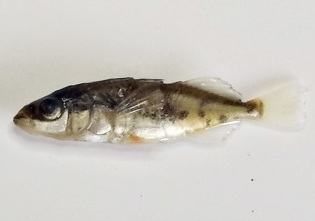
Lev Semyonovich Berg, also known as Leo S. Berg was a leading Russian geographer, biologist and ichthyologist who served as President of the Soviet Geographical Society between 1940 and 1950.

The Iceland or Icelandic catshark is a species of catshark, belonging to the family Scyliorhinidae. This catshark is found in the western Atlantic, from Massachusetts, Delaware, and the northern Gulf of Mexico, as well as the eastern Atlantic from Iceland, southwestern Ireland, the Canary Islands, Madeira, South Africa, and between 67 and 11°N. They are found in depths of 550 to 1450 meters near or at the bottom over upper continental slopes.

Bathyraja is a large genus of skates in the family Arhynchobatidae.

The smalleyed ray or smalleyed skate is a species of ray in the family Rajidae, the typical rays and skates, from the eastern Atlantic Ocean where it is found in tidal, coastal waters with sandy substrates.
Cepola pauciradiata, the Guinean bandfish, is a species of marine ray-finned fish belonging to the family Cepolidae, the bandfishes. It is found on the Atlantic coast of Africa.
Gobius senegambiensis is a species of marine fish from the family Gobiidae, the true gobies. It is native to the Atlantic Ocean from Morocco to Angola as well as the islands in the Gulf of Guinea. It is found in inshore waters on sandy bottoms. This species can reach a length of 7.3 centimetres (2.9 in) SL.

The blackspotted stickleback is species of ray-finned fish belonging to the family Gasterosteidae, the sticklebacks. This fish is found in the western Atlantic from the coasts of Newfoundland (Canada) to Massachusetts. This is a benthopelagic species of marine and brackish waters, rarely entering freshwater, which remains near the shore. It is frequently associated with floating vegetation. The male builds a nest, in which the females deposit eggs and the male guards and aerates them. It is a small fish which reaches a maximum published total length of 7.6 cm (3.0 in), although 3.5 cm (1.4 in) is more typical. The specific name honors Richard H. Wheatland who was the Cabinet Keeper, for the Essex County Natural History Society of Salem, Massachusetts and who collected type of this species in 1859.

Liparis montagui, or Montagu's seasnail, is a marine fish of the seasnail family (Liparidae). It inhabits the northeastern Atlantic, mainly around the British Isles, the North Sea, the Norwegian Sea, southern Iceland and as far north as the Barents Sea. It is a small, demersal fish, usually living between from the intertidal zone to 30 metres deep, where it hides under stones or algae. It mainly feeds on small invertebrates, such as small crabs, shrimp and amphipods. This species was described in 1804 by the Anglo-Irish writer, natural history illustrator, and amateur zoologist Edward Donovan with England given as the type locality. The specific name honours the English naturalist George Montagu who provided Donovan with an illustration and a description of this "beautiful little fish".

Ophidion josephi is a fish species in the family Ophidiidae. Widespread in the Western Atlantic from Georgia to Florida, also in the Gulf of Mexico. Marine tropical demersal fish. The specific name josephi refers to St Joseph Island in Texas where the type specimen was collected.
Kiyomatsu Matsubara was a Japanese marine biologist, ichthyologist, and herpetologist.
The longnose deep-sea skate is a large skate in the family Arhynchobatidae. It was first described in 1985 from specimens collected near New Zealand. It is known to be a deep-water skate, however lack of research trawls at depths past 1500 meters limits knowledge of the depths where the species can be found. The species is dark brown or grey, with an eponymous elongated snout. The species has been measured to be a maximum of 140 cm in total length, although size variation and growth patterns are not known.

Xyrichtys martinicensis, the rosy razorfish, is a species of marine ray-finned fish from the family Labridae, the wrasses. It is found in the western Atlantic Ocean.
Xyrichtys sanctaehelenae, the yellow razorfish, is a species of marine ray-finned fish from the family Labridae, the wrasses. It is found in the central Atlantic Ocean.
Stemonosudis bullisi is a species of barracudina found in the western-central Atlantic Ocean and the north-eastern Gulf of Mexico.
Bathyraja andriashevi, the little-eyed skate, is a species of skate in the family Arhynchobatidae found in the western Pacific Ocean.
Bathyraja bergi, the bottom skate, is a species of skate in the family Arhynchobatidae found in the north-western Pacific Ocean.
Bathyraja fedorovi, the cinnamon skate, is a species of skate in the family Arhynchobatidae found in the north-western Pacific Ocean.
Bathyraja taranetzi, the mud skate, is a species of skate in the family Arhynchobatidae found in the north-western Pacific Ocean.
Bathyraja tzinovskii, the creamback skate, is a species of skate in the family Arhynchobatidae found in the western Pacific Ocean.
Bathyraja matsubarai, the dusky-purple skate, is a species of skate in the family Arhynchobatidae found in the north-western Pacific Ocean.








